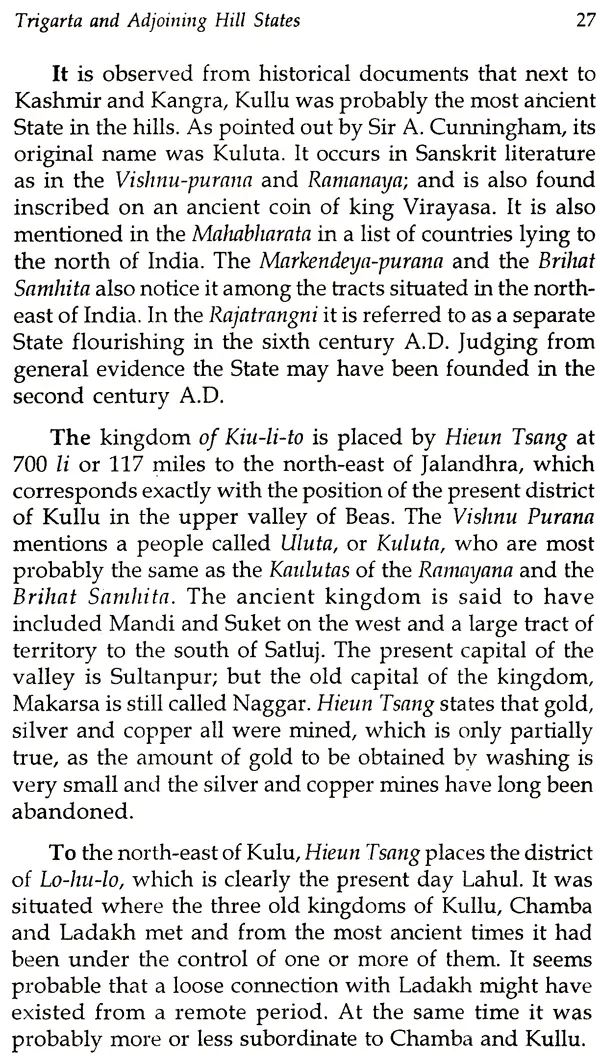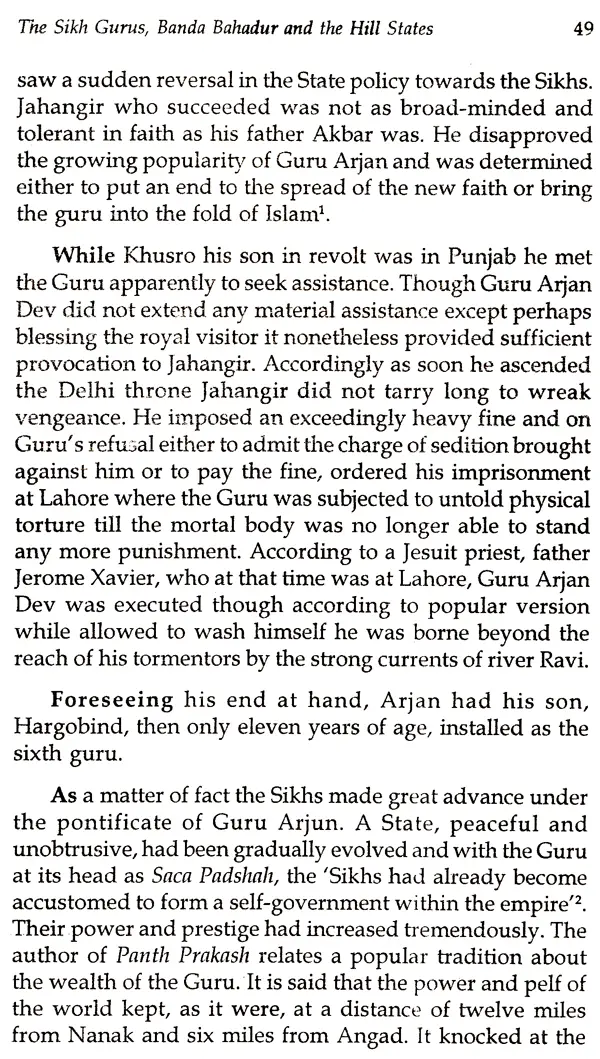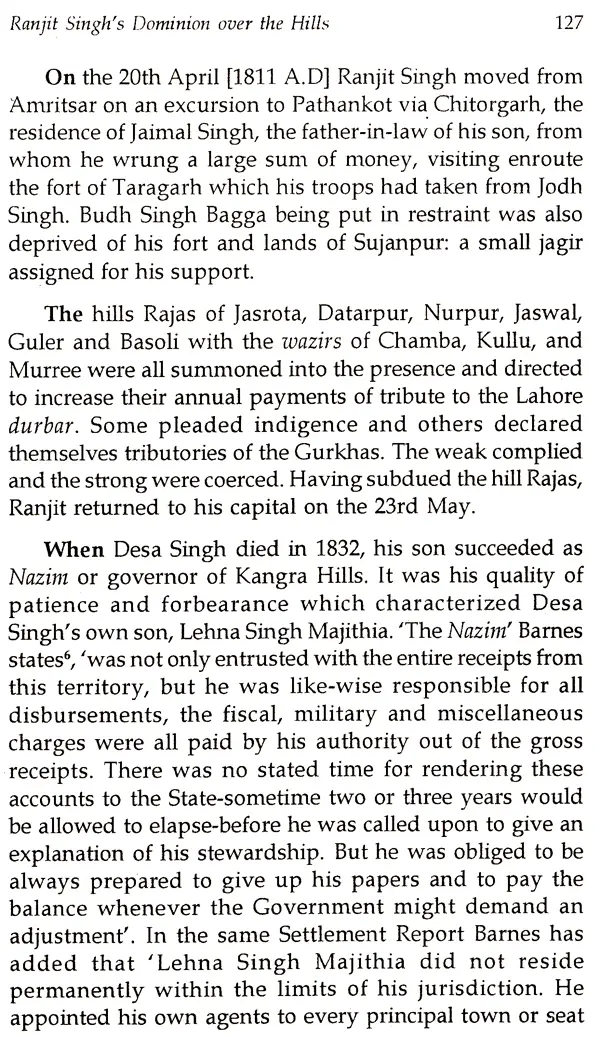![The Sikhs And The Kangra Hill States [1469-1846 A.D.]](http://occultnthings.com/cdn/shop/products/uas701_{width}x.jpg?v=1677965845)
The Sikhs And The Kangra Hill States [1469-1846 A.D.]
Book Specification
| Item Code: | UAS701 |
| Author: | V. Verma |
| Publisher: | B.R. Publishing Corporation |
| Language: | English |
| Edition: | 2010 |
| ISBN: | 9788176466868 |
| Pages: | 225 |
| Cover: | HARDCOVER |
| Other Details | 9.00 X 6.00 inch |
| Weight | 460 gm |
Book Description
The hills from which rivers Satluj and Ravi flow, a remarkable feature which Sir Lepell Griffin [The Rajas of the Punjab [1870] noted with admiration was the pedigree of the Chiefs which stretched back in unbroken succession for several thousand years. In a powerful and moving language he has commented: Before the Mohammad, god intoxicated shattered the idols of Arabia, before the founder of the Christian faith gathered his few disciples by the Lake of Galilee, the little Rajput principalities were existing in their quiet valleys; and when the day arrives that the name of England shall be no more a power in Hindustan, but only avaguer memory, one leaf of her long and wondrous story, the Rajputs will still be ruling the ancient valleys and tracing their ancestry to the Sun. The prophecy though did not come true. Much before the English had left the shores of India, the Kangra princely order sprung from the root stock of Katoch House had disappeared from the face of the Punjab province. Though in the prime of its glory under Maharaja Sansar Chand [1775-1823], Kangra, once an unrivalled regime, over-lord of all the neighbouring princely hill States, at long last was vanquished by Ranjit Singh the Maharaja of Punjab. How did the two great powers of Punjab -the Hill Rajas and the Sikhs - co-existed and interacted during the closing years of the eighteenth century and upto the first half of nineteenth century has been chronicled by the author in a lucid and coherent manner. The book unravels an interesting chapter of the history of Himachal Pradesh, which so far has received little attention from its historians. By the middle of 1993 when the author, had relinquished, public office on the State Consumer Redressal Commission and had plenty of leisure time to indulge in his pet hobby, he seriously took up writing. His first book "Emergence of Himachal Pradesh" came out in the second half of 1995. Advised by the publishers to focuss on tribal studies instead, he brought out "Gaddis of Dhauladhar" in 1996; Pangi - A Tribal Habitat in Mid Himalayas during the following year. By the end of 1997 "Spiti - A Buddhist land in Western Himalayas" had been published by B.R. Publishing Corporation, Delhi, and "Ban - Gujjars" in 1999. Before his latest book "Shimla Hill States in the 19th century" was published in 2007, he had brought out "Kanauras of Kinnaur" [2002] thus covering all the important Scheduled Tribes in the State. Though Bhot, Jad, Lahaulas, and Swangalas are similarly scheduled Tribes, their individual population constitutes an insignificant proportion of the State's demographic composition. Majority of these people have since assimilated in the main stream leaving not much trace of their aboriginal traditions and customs.
Representing a fascinating part of the mightiest mountain of the world, Himachal Pradesh continues to be the 'abode of gods', thickly overlaid with peace and tranquility, which made it the tapasthali of saints and sages, largely intact. Throughout history its splendorous mountains and lovely hills and hillocks have unfailingly offered the safest retreat to the people of northern plains, whenever they were hard pressed by foreign invaders. The Rajput and local rulers when driven out of their ancestral principalities took refuge in its fastness leaving behind their ancestral heirlooms and subjects defenceless. Some five centuries ago the Sikhs like wise sought security amidst its thick forests and enclosed valleys or duns, when uprooted from their hearth and home by marauding columns of the Mohammedan invaders or later when persecuted by the Afghan and Mughal rulers for their faith. The Himalayan or Shivalik ranges form the backwoods of the plains of Punjab, the most fertile region watered by the five classical rivers. Through out history the province had held a peculiar interest. Invasions by land from the west had been launched across its great plains. For centuries it acted as a buffer zone till the English who, possessing sea power, were able to outflank the mountain ranges which guarded the north and west of India. First came the Aryan conquerors, who in their turn, were sub-dued by the Scythians, whose hordes having over-run parts of Asia found their way into the valleys of the Indus. Alexander made the Punjab the classic ground of his conquests and it was in the Punjab that in later times armies of Islam after over-running Asia, Africa, and Southern Europe obtained their first footing on Indian soil. For upward of two centuries the Hindu rulers of the country battled the aggression of the Mohammedan invaders. Mahmud subverted the land in every conceivable form of misery and degradation carrying away thousands of its inhabitants into worst form of slavery. The hordes of Changez Khan, the Tartar, inflicted on the Punjab all the horrors, the lands as far as Hungary, Russia, Germany had endured at his hands. Tamerlane, who made his capital Samakand, 'the mistress of Asia' by enriching it with the spoils of a thousand cities, made the Punjab another scene of his military prowess. Nadir, the Abdali, Ahmad Shah, and Babar, each in his turn, used the Punjab as the gateway to the riches of Delhi and beyond. The Punjab is the home of the Sikhs and of their faith Sikhism, founded by Nanak [1469-1539]. Guru Arjan's contribution to the Sikh faith was to give his life as a martyr. Guru Teg Bahadur [1621-1675] gave his head but not his secret [Sis diya par sirr na diya], also for the sake of the faith. The last and tenth Guru Gobind Singh established the Khalsa, and fought an unremitting war against the Mughals. Before his death the tenth master had declared that after him the guruship shall vest in the Granth Sahib, formally installed in the temple of Amritsar in the year 1604 by Guru Arjan. For a few years Banda, the chosen disciple of the tenth Guru, wreaked havoc on the enemies of the Khalsa. In 1716 however, he was captured, tortured and put to death. The history of the Sikhs from the fall of Banda to the establishment of their political power in the Punjab in 1764-65 is a record of the titanic struggle the Khalsa had to wage and rivers of blood its followers had to shed. In between, in the year 1748 eleven Sikh confederacies were born which carved out their own individual misls under their respective warrior leaders. Of them Ranjit Singh of Sukherchakia in due course occupied the centre stage and founded the Sikh monarchy in the Punjab after years of toil and persevering energy and a lot of diplomacy and duplicity. In the Shivalik hills contemporarily flourished twenty two Hindu Rajput Chiefs; the Chief among them Maharaja Sansar Chand ruled the Kangra kingdom, who during most of the period covered by this book, is seen scheming to re establish his hold on Kotkangra [Kangra fort], the costliest jewel in the crown of the Katoch royalty, which had been lost to the Mughals. It is not my object to record the biographies or the political history of the reigning families of these States as much as to give a connected account of their relations with the Sikh misls and after them with Ranjit Singh, the Maharaja of Punjab, and his ill-starred successors almost to the time the Sikh power in the Punjab was completely extinguished and with its demise remanents of the hill princes were flung on the dung heap of history. A brief account of the ten Gurus and Banda Bahadur, who followed Guru Gobind, and their connection with the hills has been sketched in Chapter-III mainly to serve as background: the appendices provide an insight into the salient features of the faith.
**Contents and Sample Pages**

















